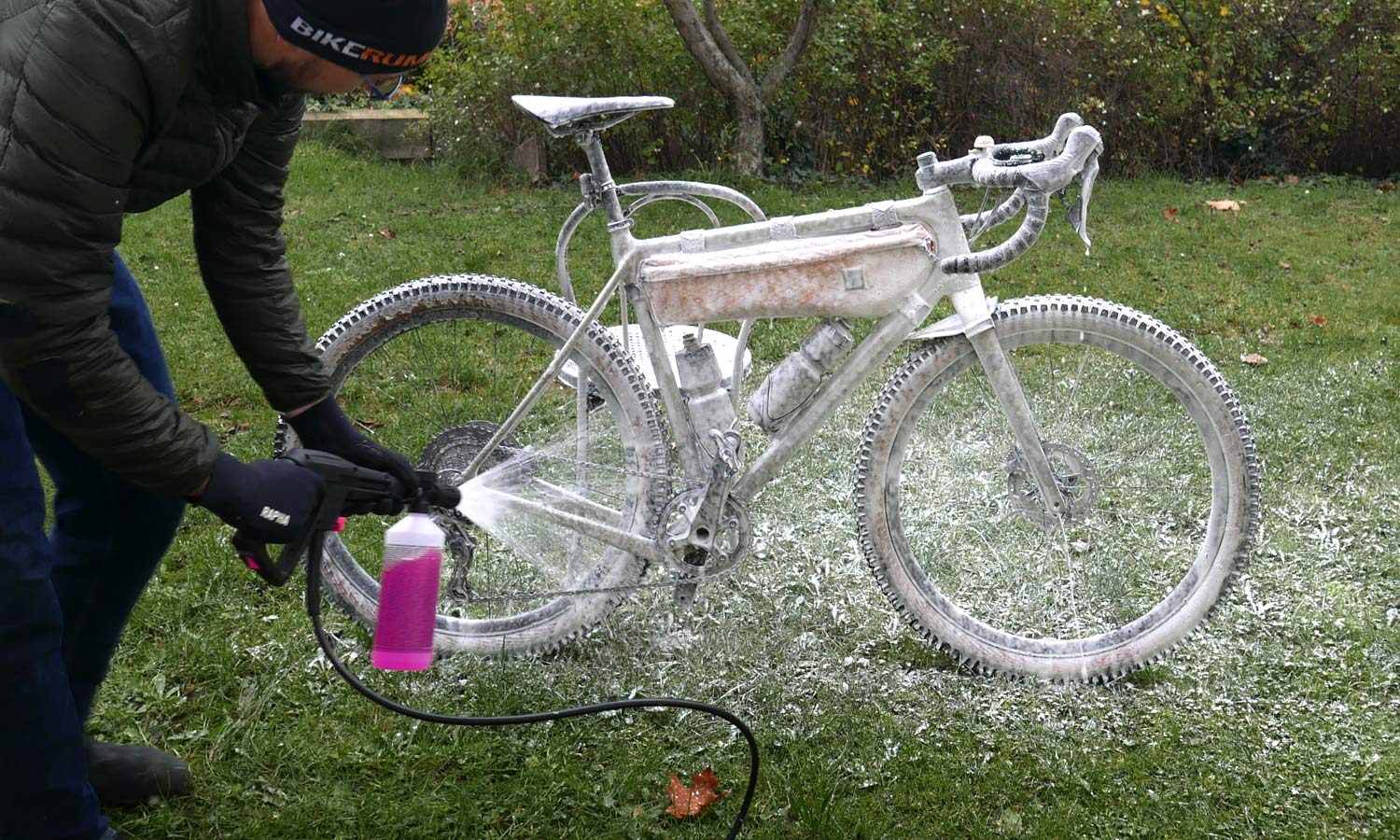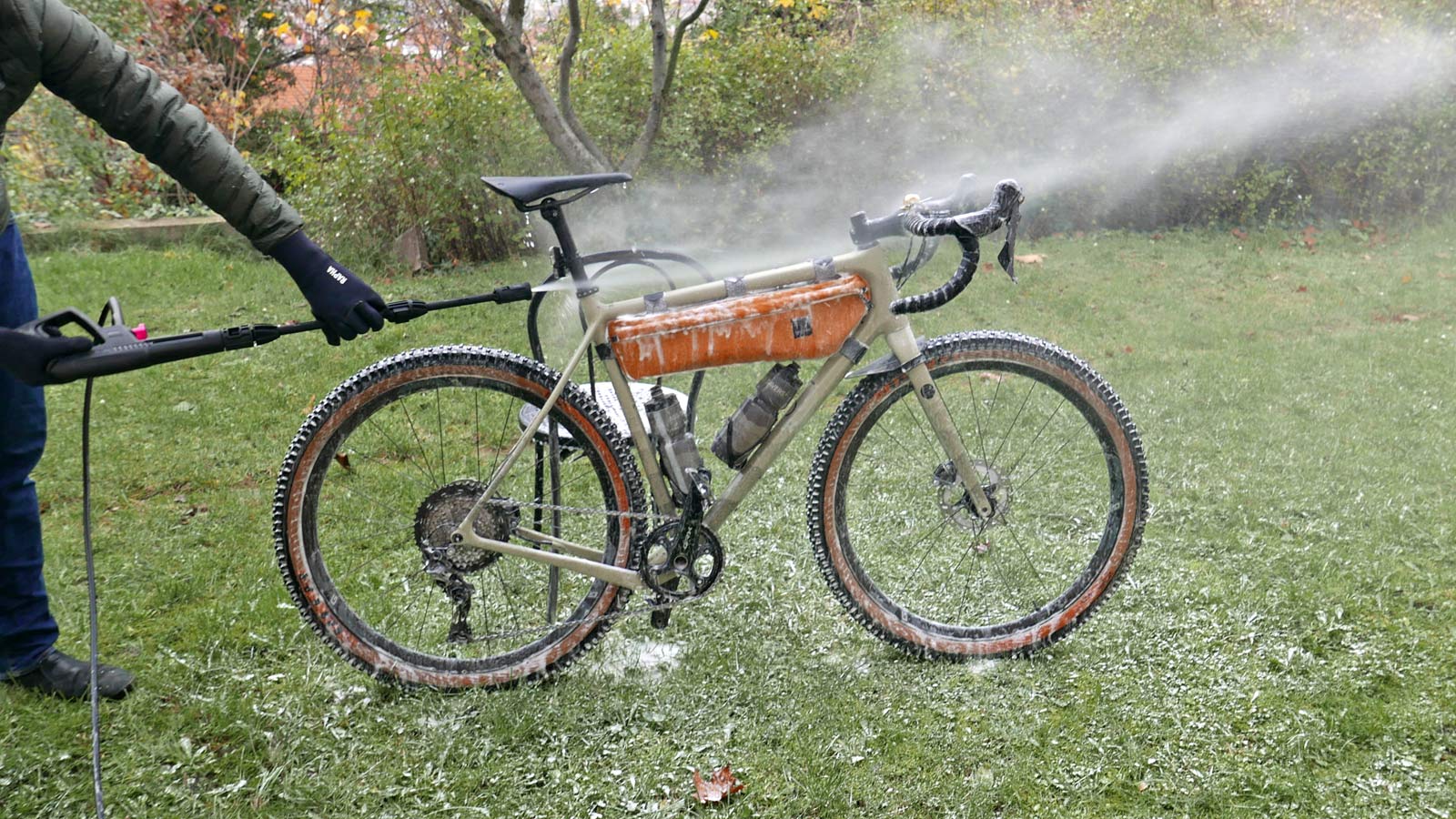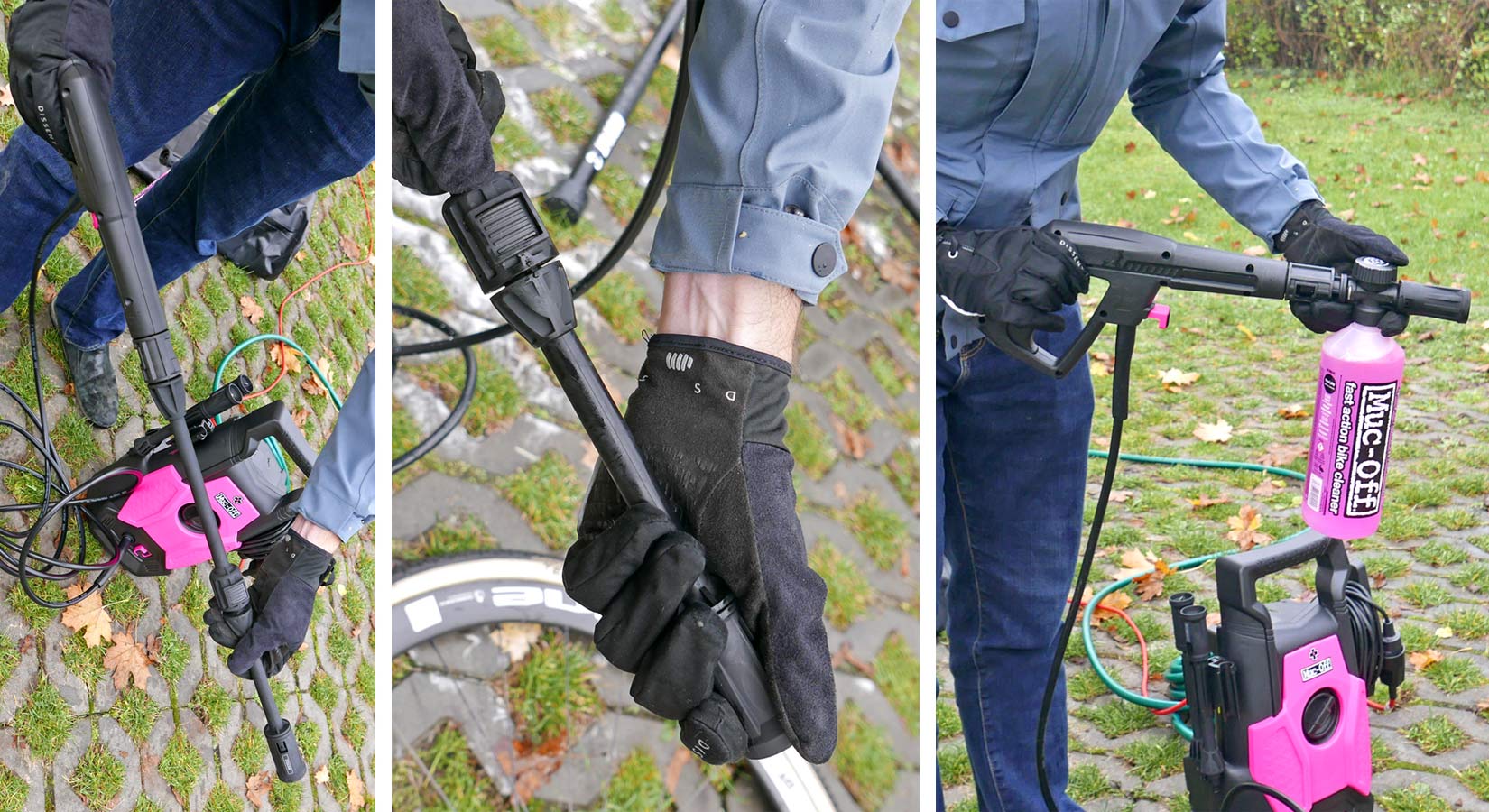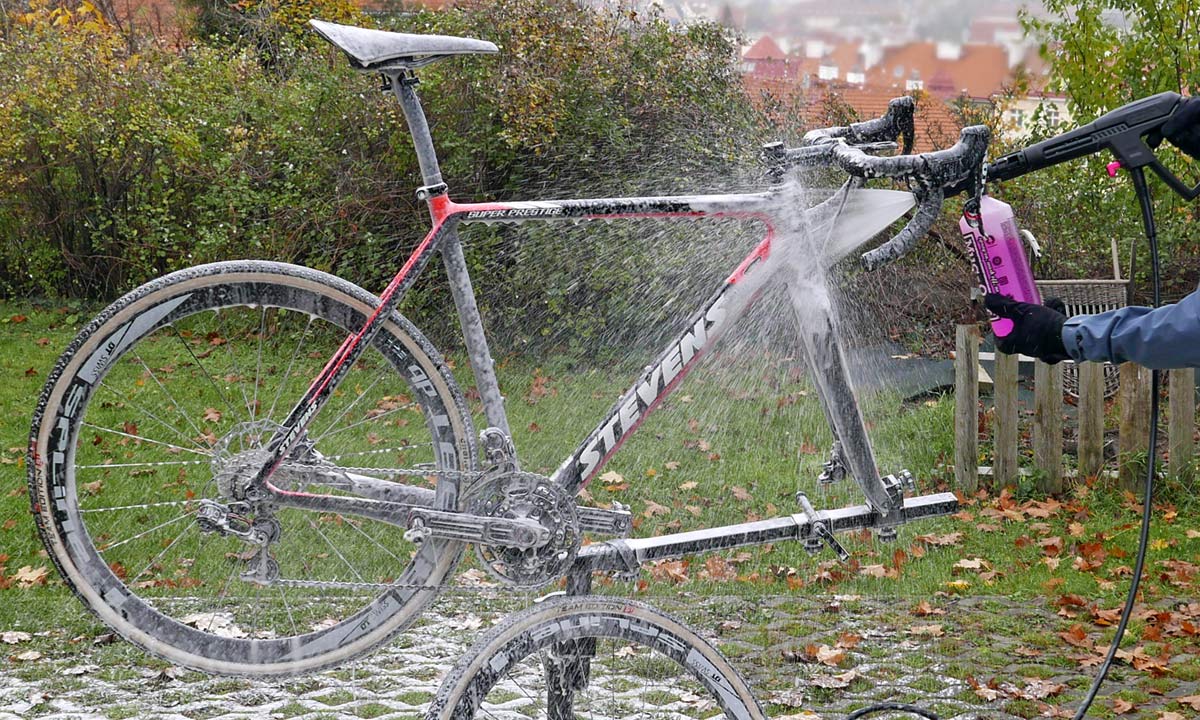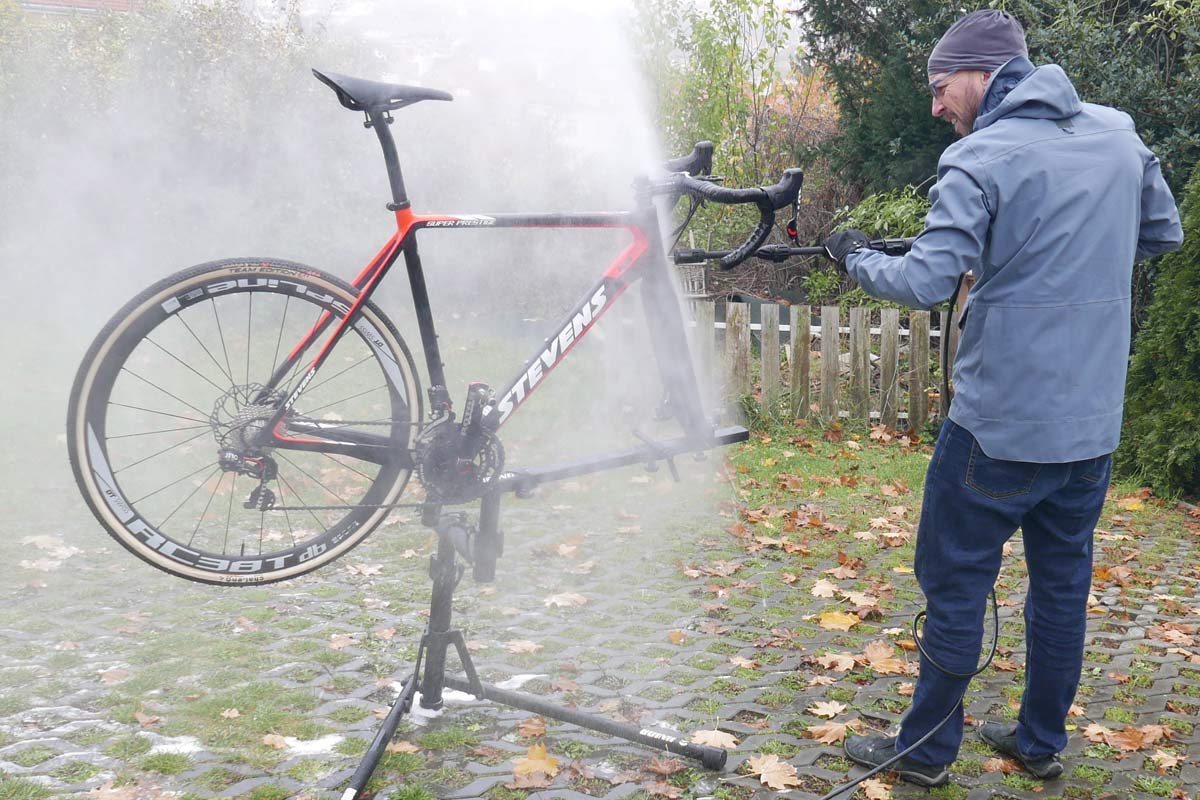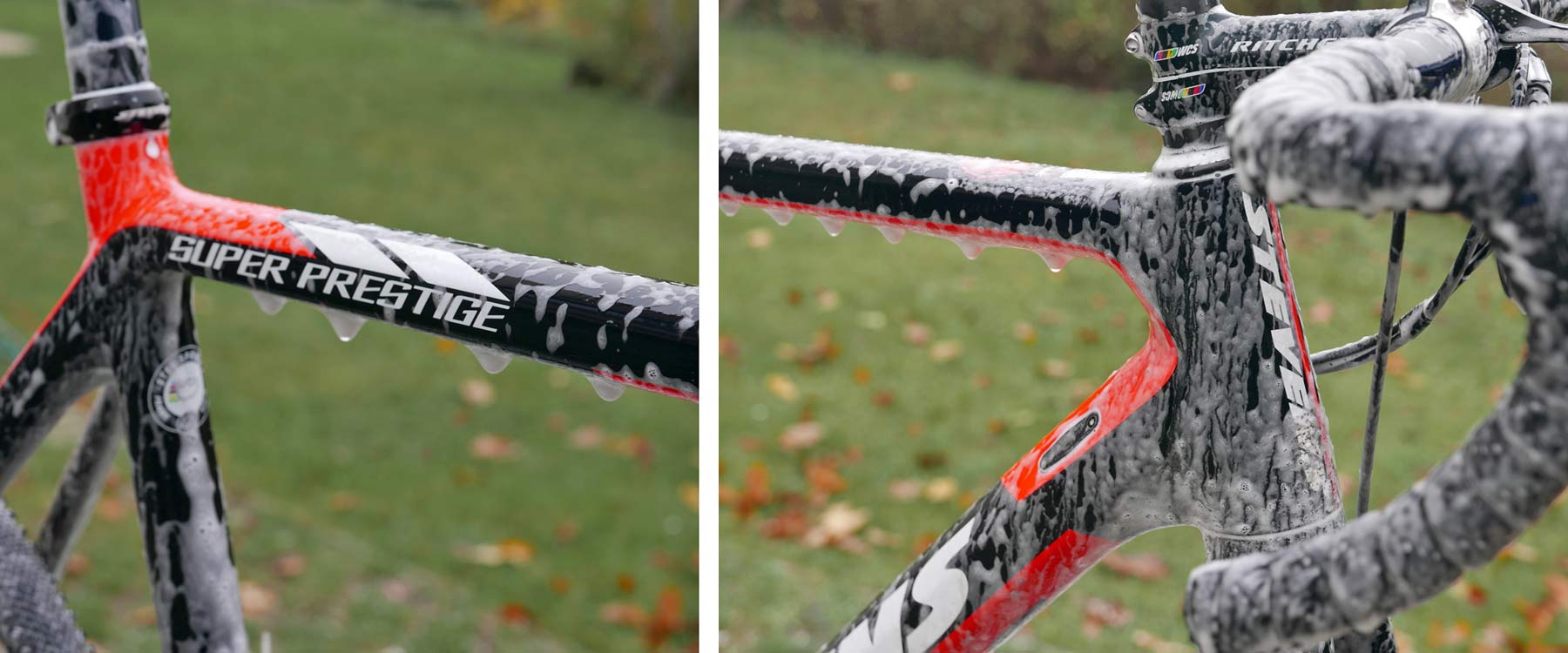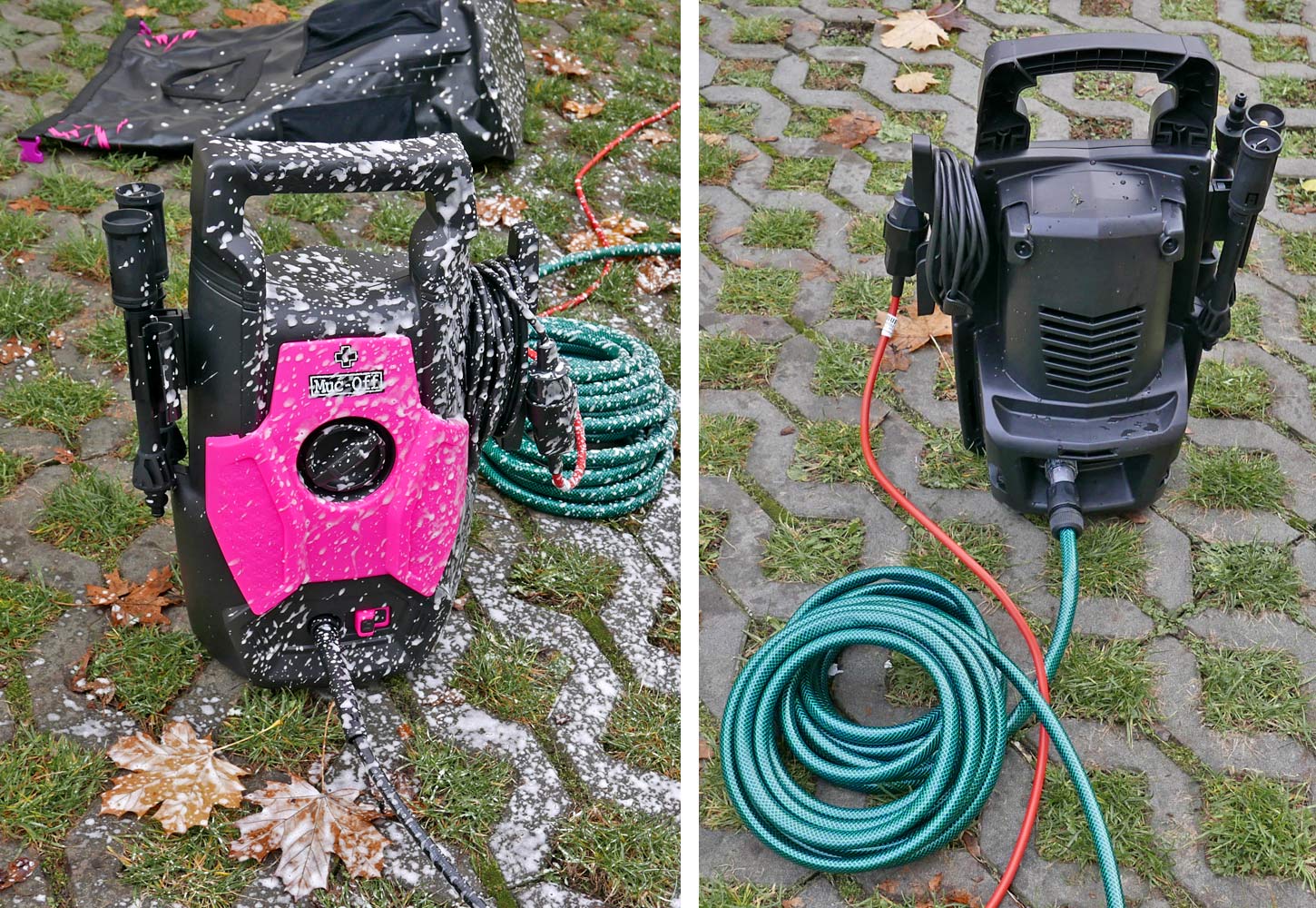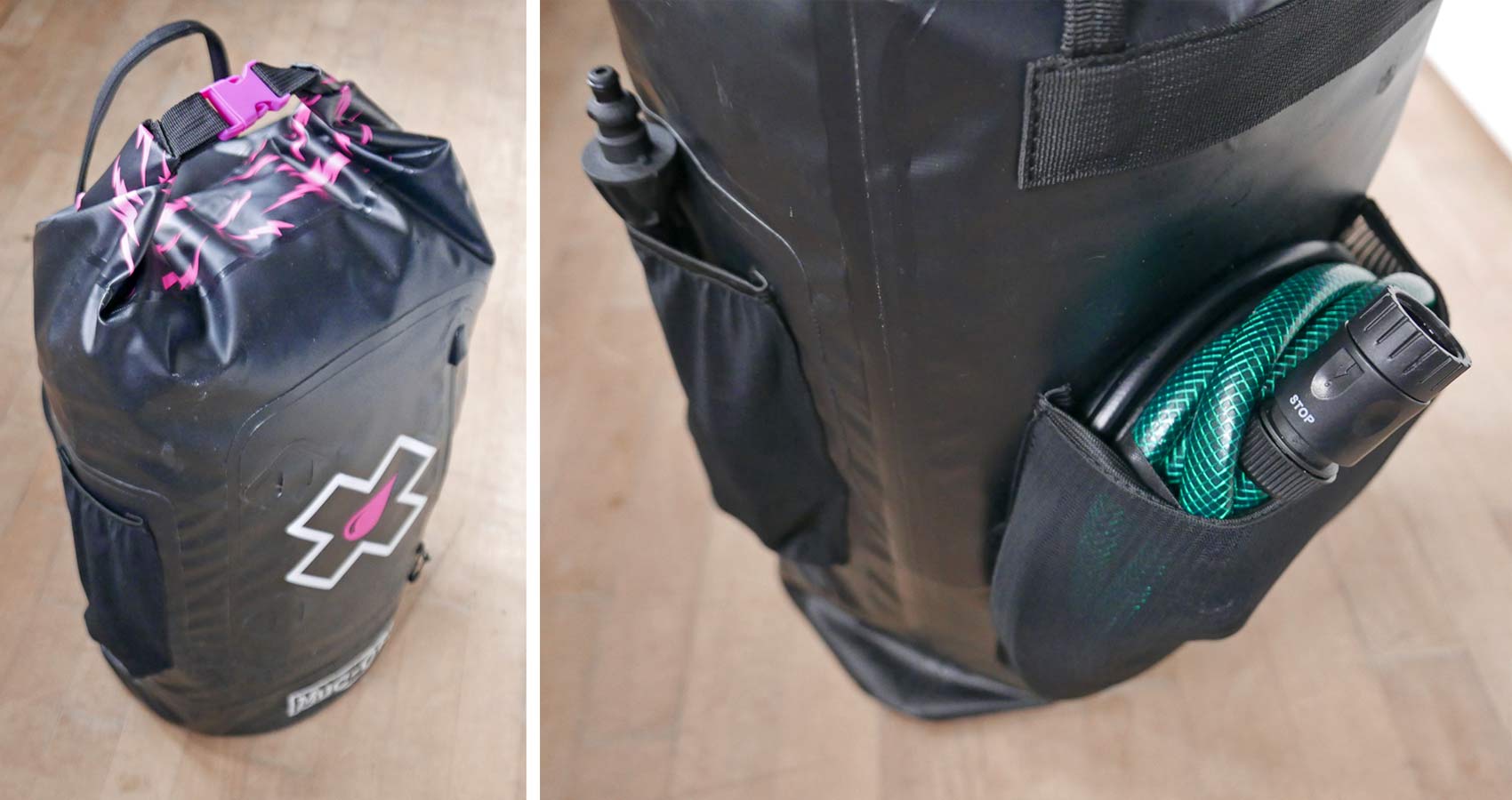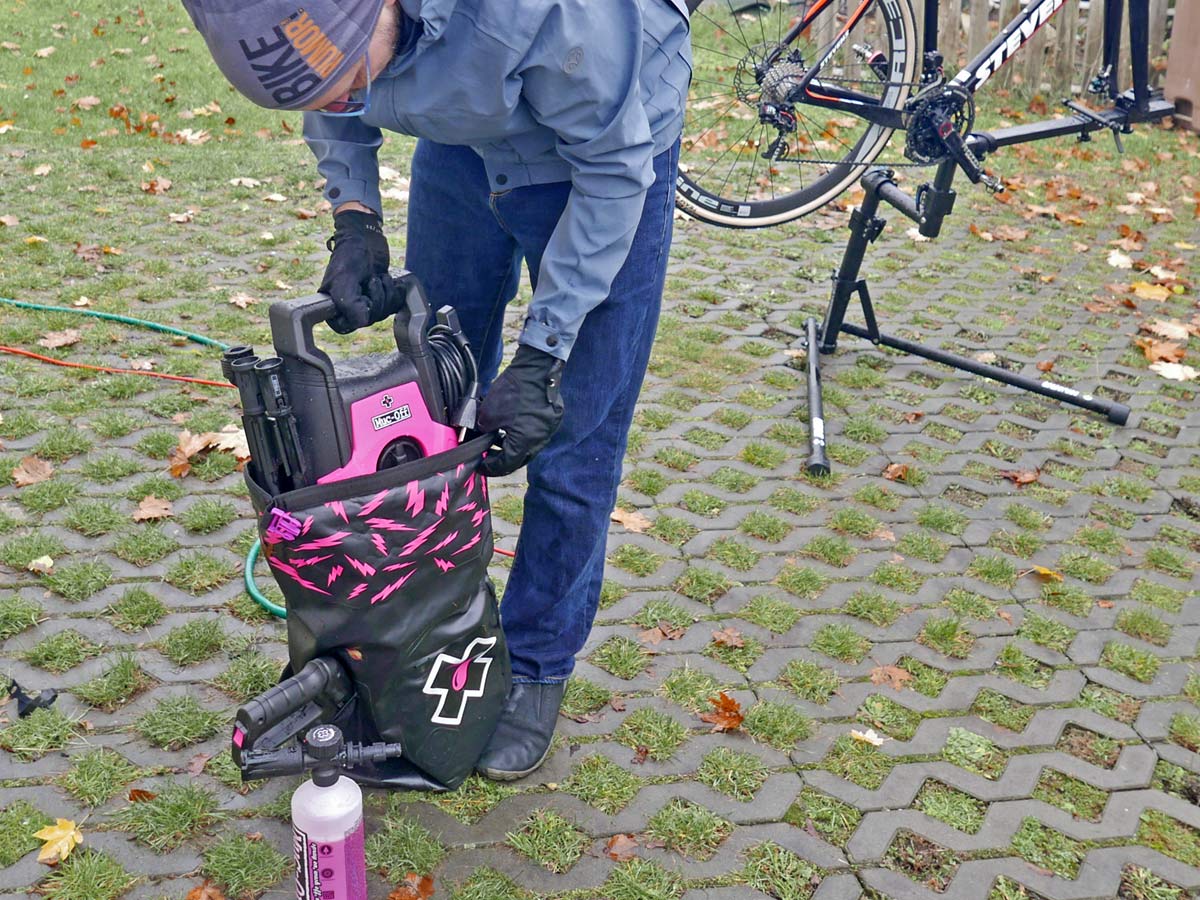We’ve been blasting Nano Tech cleaner foam onto dirty bikes for several weeks now, and can attest to the Muc-Off Pressure Washer as a fun & effective way to knock the mud off our rides. Muc-Off showed us their pink pressure washer last spring, but at the time it was a UK-only deal. And we wondered if we really did need a “bicycle-specific” pressure washer…
Muc-Off bicycle-specific Pressure Washer with Snow Foam
Muc-Off’s Pressure Washer is being billed as both ‘bicycle-specific’ & ‘motorcycle-specific’ to two different groups of consumers. What that amounts to is that in includes two medium-pressure nozzles (labelled as BICYCLE & MOTORCYCLE) that each deliver a less intense stream of water than a standard pressure washer. That makes it much safer for the regular end user to blast away at their bike’s bearings, pivots, suspension & drivetrain components without fear of blowing out critical grease. Then, Muc-Off also includes a third adjustable nozzle for more stubborn grit & grime.
But do we really need a bicycle-specific pressure washer?
In truth, you don’t really need a bicycle-specific pressure washer. I’ve been carefully washing bikes for over two decades (including many hastily & more carelessly washed cyclocross bikes at cross races) with much success. And as long as you don’t aim the jet of water directly at bearings & seals, you just need to regularly maintain (read: relube & regrease) anything that is supposed to move on your bike to keep it spinning smoothly.
With that said, this new Muc-Off Pressure Washer is probably the most user-friendly solution I’ve used for cleaning both wet mud & hardened dirt off of a bike. It totally simplifies the cleaning process, and then packs away easily when you are done.
So how does the Muc-Off Pressure Washer work?
Like most high-quality pressure washers, Muc-Off’s uses interchangeable nozzles that have different power output – they call them Lances. Muc-Off doesn’t list detailed specs for each nozzle, rather rating them overall with a regular operating pressure up to 70bar (1000psi) with peak max pressures of 100bar (1450psi), all with a 5.5L/min standard water consumption.
The different ~20cm lances (which build in the different fixed nozzles) are proprietary and only attach to the trigger mechanism with another ~25cm extension. It’s a relatively easy process but requires a bit of aligning small arrows to make it all work, so a tad finicky.
Instead of vastly different spray patterns, the Muc-Off Pressure Washer has a middle-pressure Bicycle Lance (stronger than any standard hose, but using less water concentrated to a more controllable area), a medium/high-pressure Motorcycle Lance (that feels about half again more powerful and close to a wide 30° stream from an average home pressure washer), and lastly an adjustable custom Muc-Off Lance that goes from just spraying mist to focusing even higher pressure.
The bike nozzle knocked pretty much all mud & caked dirt off my bikes, and the moto nozzle easily picked off the worst grime when I needed to get in close. I haven’t really need to do much at all with the third, adjustable one.
But what about that foam party?
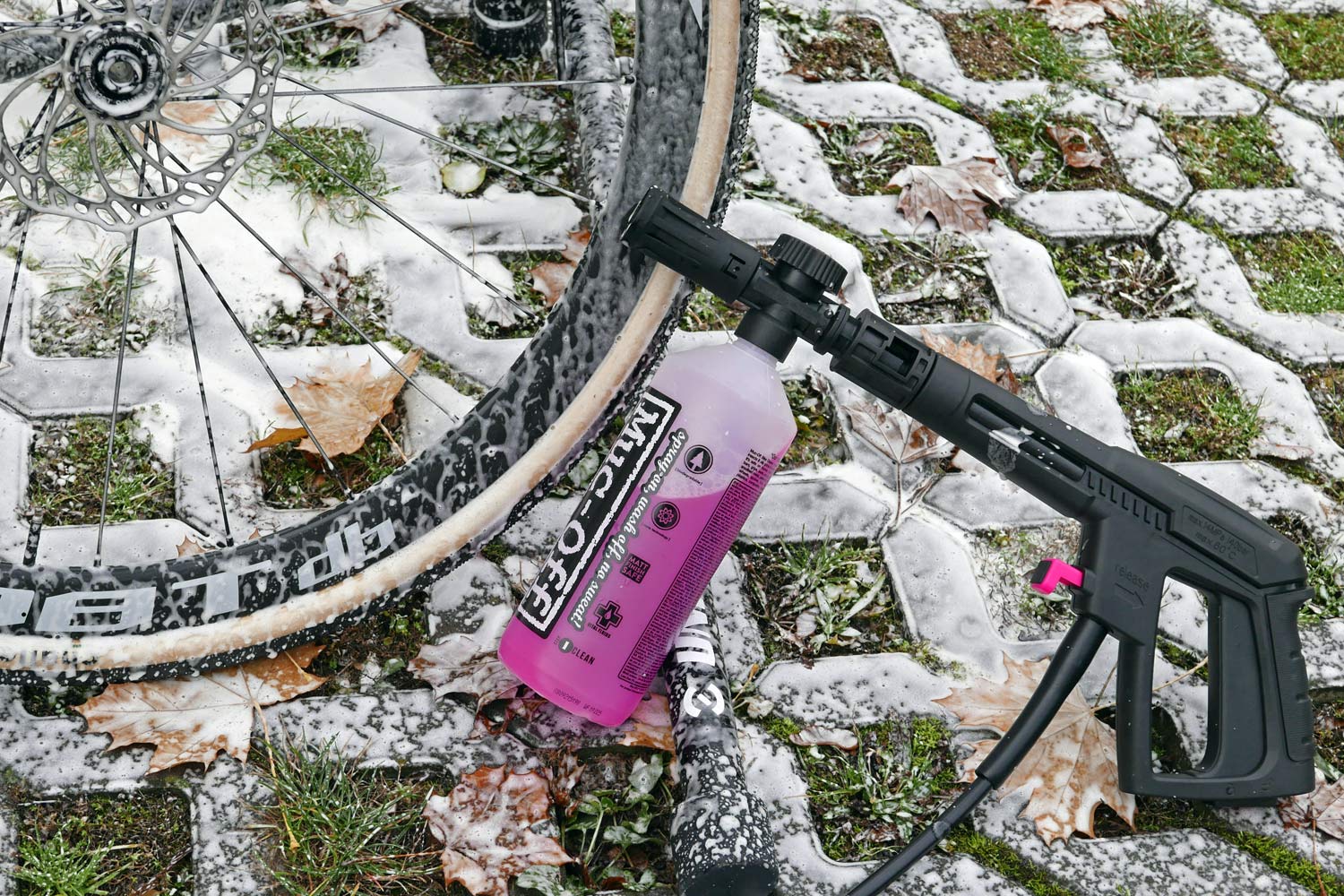 But probably the best thing about the entire Muc-Off Pressure Washer has been the Snow Foam Lance that blows tons of mud-eating foam when you attach a liter bottle of Muc-Off Nano Tech cleaner. They tout the pink Nano Tech as a powerful cleaner that breaks down dirt & grime, but you need to let it sit on the bike for 3-5 minutes.
But probably the best thing about the entire Muc-Off Pressure Washer has been the Snow Foam Lance that blows tons of mud-eating foam when you attach a liter bottle of Muc-Off Nano Tech cleaner. They tout the pink Nano Tech as a powerful cleaner that breaks down dirt & grime, but you need to let it sit on the bike for 3-5 minutes.
The Snow Foam Lance makes it easy to just coat the entire bike quickly, then walk away for a break while it does its magic. It is also biodegradable and free of solvents, so it’s been safe to just wash away into the grass in my yard.
Then once five minutes is up, I quickly swap back on the Bicycle Lance and blast away willy nilly.
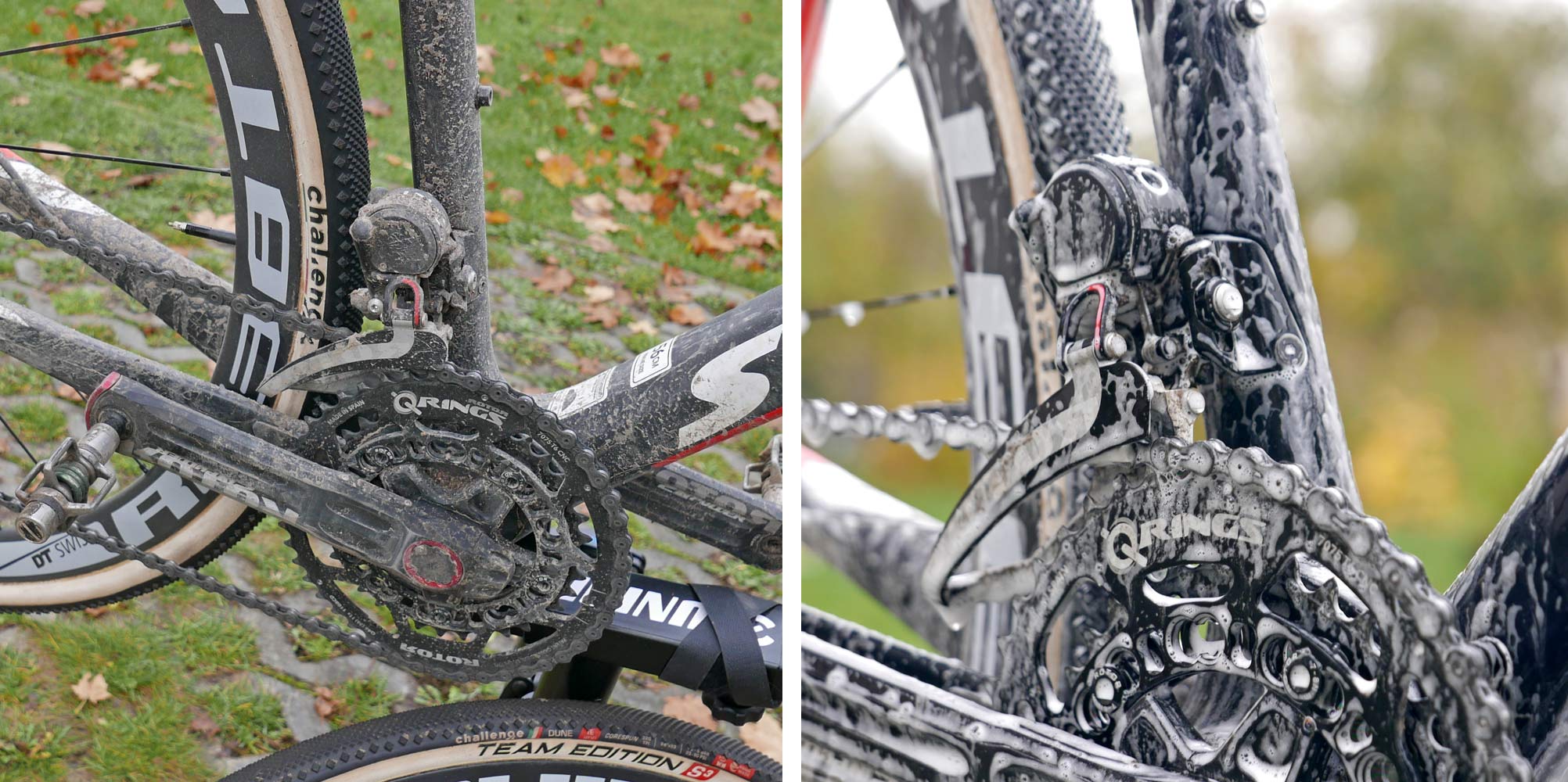 Looking at grit I’ve allowed to cake on & harden, it all comes off in a single pass once the Nano Tech has done its job.
Looking at grit I’ve allowed to cake on & harden, it all comes off in a single pass once the Nano Tech has done its job.
And watching the scrubbing bubbles drip down the bike is a relatively entertaining way to pass the time while you wait, or go for a beverage break….
Final thought on the Muc-Off Pressure Washer
If you already have a pressure washer and are comfortable with being careful when you clean you bike, it probably doesn’t make sense to go buy a new one, just because this is pink & made for bikes. But if you put off buying one for fear of destroying bearings, it may be time to give Muc-Off another thought.
The Muc-Off Pressure Washer is nice and compact, plugs into a regular outlet & connects easily to most hoses with a standard quick connect. A side mount stores 3 lance attachments (or I put the two I use most there, plus the required extension) and coils up the 5m power cord.
Then, everything tucks nicely into its own custom made drybag. That means it travels well, and comes into the house without making a mess. (But you still have to figure out a way to properly dry it before storing for any period of time, lest something starts to grow inside. I’ve taken to giving the Pressure Washer its own 3m piece of hose (that fits in the rear external mech pocket with its own high-pressure hose) so I can quickly set it up to clean bikes without pulling out my regular hose. That’s especially useful since much of my bike cleaning happens in cold winter cyclocross & slushy gravel & MTB months.
Inside there is plenty of room for the Snow Foam Lance, a 1L bottle of Nano Tech cleaner, and the pistol grip/wand, all of which don’t get specific internal storage pockets but are more securely packed inside.
Muc-Off Pressure Washer Pricing & global availability
All-in-all, combining the Nano Tech foam sprayer with a medium-pressure electric pressure washer has made this a faster, easier way to clean my bikes than any hand method. And it requires much less care & attention than any conventional high-pressure washer I’ve used. And now the best part is its broader availability…
The Muc-Off Pressure Washer is available today to order direct in the UK, EU & US, with shipping to head out next week. In the US it is only offered in the complete kit like we’ve been using, for $175 including the Pressure Washer, drybag, Snow Foam Lance, 1L of Nano Tech bike wash & a 1L. In the UK the same kit sells for £120, and in the EU 140€. The UK also offers the Pressure Washer, the drybag & Snow Foam attachment individually, but those aren’t currently in stock due to high demand for the bundles.
